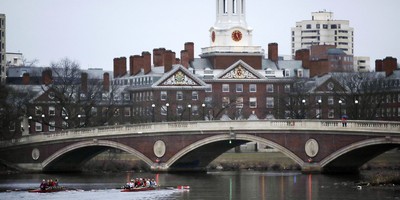By now, just about everyone has had an opportunity to pick apart President Obama's fatuous remarks about how the private sector is "doing fine," while public employees are suffering. The president's comments, of course, were not even within viewing distance of reality. After all, despite some recent hiring, the private sector is still 4.5 million jobs below its 2008 employment peak. And while public employment is also down from 2008, that ignores a boom in state and local government hiring from 2006 to 2008. The current decline still leaves state and local employment about where it was in 2006. Meanwhile, federal employment is up 88,000 jobs.
But a much bigger question is: Why is the private sector doing so poorly? Perhaps because most businessmen are not that dumb.
If one includes the unfunded liabilities of Social Security and Medicare, this country's real total indebtedness could run as high as $129 trillion (in current present value). Even under the most optimistic scenarios, our real debt exceeds $92 trillion. Measured as a percentage of GDP, our total debt exceeds the total debt of Greece or Spain. By comparison, the total book value of all U.S. companies is roughly $23 trillion. It's not a perfect comparison (future taxes will be paid out of future wealth), but it does put things in perspective. Any business owner looking down the road, and seeing debt four to five times the size of his or her company, is likely to decide that this is not a great time to expand or hire new workers.
That is why the president's preferred solution of offsetting private-sector losses with increased public-sector hiring is so mistaken. Those new public-sector jobs must be paid for with more debt and taxes borne by the private sector. As Frédéric Bastiat wrote in 1848, public employment "gives jobs to certain workers. That is what is seen. But it deprives certain other laborers of employment. That is what is not seen." Bastiat concluded that trying to increase employment through government was "a ruinous hoax, an impossibility, a contradiction."
Recommended
For example, a study done for the European Commission by economists at the University of Paris looked at public employment in 17 countries between 1960 and 2000. It found that for every public-sector job created, 1.5 private-sector jobs were destroyed. Thus, hiring more government workers actually increases the level of unemployment.
And, perhaps more directly relevant, a study of President Obama's stimulus bill by Timothy Conley of the University of Western Ontario and Bill Dupor of Ohio State concluded that, while the stimulus created or saved some 450,000 government jobs, it destroyed or prevented the creation of more than twice as many private-sector jobs.
Of course, in general, we know that an increase in the size of government slows economic growth. As Harvard's Robert Barro points out, there is a "significantly negative relation between the growth of real GDP and the growth of the government share of GDP." Under President Obama the federal government consumes 24 percent of GDP, a one-third increase over the historic post–World War II average of 19.8 percent. Throw in state and local government spending, and government spending now amounts to 36 percent of GDP.
President Obama is correct that much of this spending binge began under President Bush, but Obama's policies have taken the Bush spending (including one-time spending hikes such as TARP) and turned them into the new baseline for future spending. And the president would have spent even more if he could have gotten away with. The purpose of last week's press conference, after all, was to renew his call for more spending. The president says "more spending," and businesses correctly hear "more debt" and "higher taxes."
This long-term burden on American business comes on top of short-term uncertainty. In January 2013, the Bush tax cuts will expire, leading to the largest tax hike in U.S. history unless Congress can reach an agreement. If reelected, President Obama seems determined to use this potential "fiscal cliff" to push for higher taxes on the wealthy, businesses, and investors. The president's insistence, in particular, on raising capital-gains taxes will discourage business investment and expansion, while the hike in federal income taxes will fall especially hard on small businesses and Subchapter S corporations, which often file taxes as individuals.
Also ahead, pending a decision from the Supreme Court, is the potential implementation of Obamacare. Most of the law's tax hikes, $569 billion over the first ten years, fall on businesses. Next year, for example, there would be new taxes on medical devices and investment income, among others. And in 2014, the law will impose a mandate on employers with 50 or more workers to provide their workers with health insurance, at a cost of $4,450 on average, or else pay a $2,000-per-employee fine. As former Labor Department economist Diana Furchtgott-Roth explains:
The $2,000 per worker penalty raises significantly the cost of employing full-time workers, especially low-skill workers, because the penalty is a higher proportion of their compensation than for high-skill workers, and employers cannot take the penalty out of employee compensation packages. Suppose that a firm with 49 employees does not provide health benefits. Hiring one more worker will trigger a penalty of $2,000 per worker multiplied by the entire workforce, after subtracting the statutory exemption for the first 30 workers. In this case the tax would be $40,000, or $2,000 times 20 (50 minus 30).
Michael Tanner is a senior fellow at the Cato Institute and author of Leviathan on the Right: How Big-Government Conservatism Brought Down the Republican Revolution.
More by Michael D. TannerIf you were that small-business owner with 49 employees, how fast would you run out to hire that 50th worker? In fact, a Gallup survey of small businesses found that nearly half (48 percent) cited Obamacare as a reason why they are not hiring. It's worth noting that in France, another country where numerous government regulations kick in at 50 workers, there are 1,500 companies with 48 employees and 1,600 with 49 employees, but just 660 with 50 and only 500 with 51.
And, if Obamacare is not enough of a burden on business, 2013 will also see the onset of many of the new Dodd-Frank regulations on banking, lending, and finance.
President Obama seems wedded to an old-fashioned Keynesian philosophy of trying to revive the economy by using government hiring and spending to increase consumer demand. By now we should have learned that no amount of pump-priming is going to help, as long as businesses are worried about the crushing burden of debt, taxes, and regulation in their future.
That's the real truth behind President Obama's gaffe: He's not just out of touch; he's wrong.
This article appeared on National Review (Online)

























Join the conversation as a VIP Member